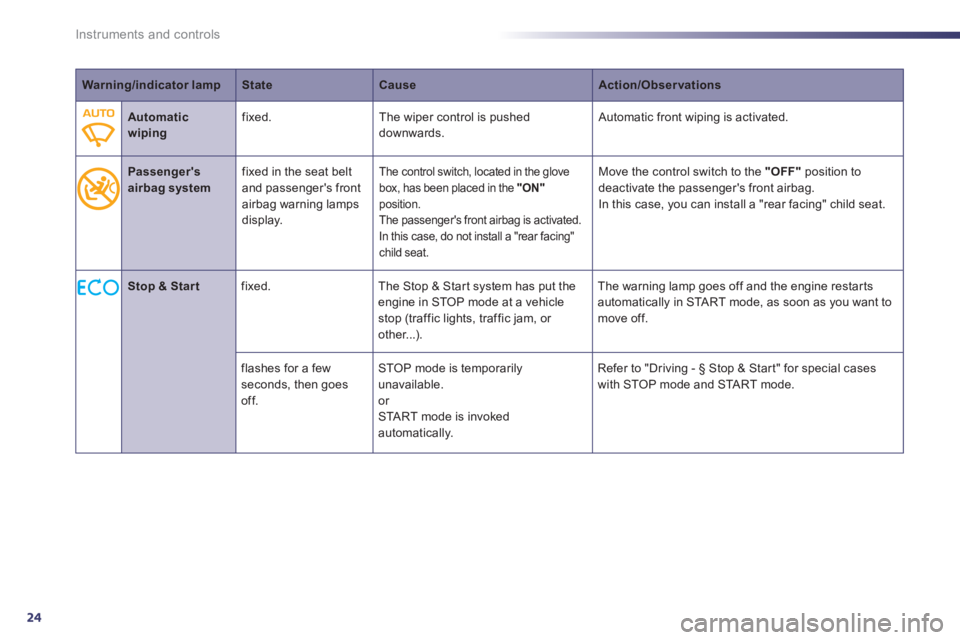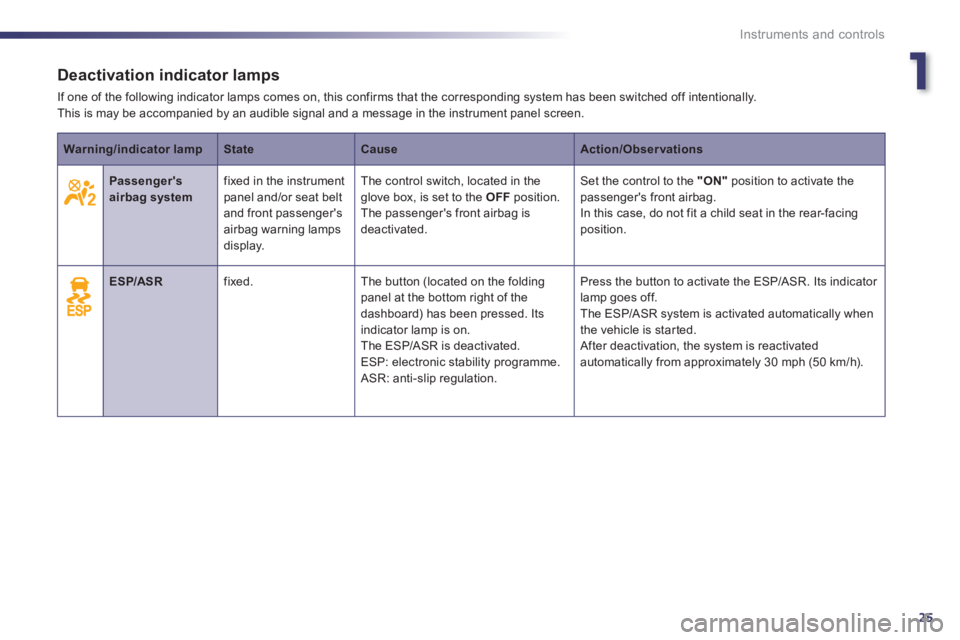Page 5 of 340
.
.
Contents
Child seats 146
ISOFIX child seats 152
Child safety
Direction indicators 157
Emergency or assistance call 158
Horn 158
Ty r e u n d e r- i nfl ation detection 159
ESP system 160
Seat belts 163
Airbags 166
Safety
Temporary puncture repair kit 170
Changing a wheel 176
Changing a bulb 183
Changing a fuse 192
12 V battery 196
Energy economy mode 199
Changing a wiper blade 200
Towing the vehicle 201
Towing a trailer 202
Fitting roof bars 204
Accessories 205
Practical information
Opening the bonnet 208
Running out of fuel (Diesel) 209
Petrol engines 210
Diesel engines 211
Checking levels 213
Checks 216
Checks
Petrol engines 218
Petrol weights 219
Diesel engines 221
Diesel weights 224
Dimensions 227
Identifi cation markings 228
Technical data
Emergency or assistance 229
JBL equipment 231
Peugeot Connect Navigation (RT6) 233
Audio system 287
Audio equipment and telematics
Alphabetical index
Visual search
Page 15 of 340
.
13
i
Familiarisation
Sitting comfortably
Door mirrors
Adjustment
1.
Selection of the mirror.
2.
Adjusting the position of the mirror glass.
3.
Deselection of the mirror.
68
Other functions...
Folding/Unfolding.
Rear view mirror
Manual day/night type
1.
Selecting the "day" position of the rear
view mirror.
2.
Rear view mirror adjustment.
Automatic day/night type
70
1.
Automatic detection of day/night mode.
2.
Rear view mirror adjustment.
1.
Fitting the belt.
2.
Fastening.
3.
Check that the belt is correctly fastened by
pulling on the belt webbing.
Front seat belts
163
Page 19 of 340
.
17
Familiarisation
Passenger safety
1.
Open the glove box.
2.
Inser t the key.
3.
Select position:
"ON"
(activation), with front passenger or
"for wards facing" child seat,
"OFF"
(deactivation), with "rear facing"
child seat.
4.
Remove the key keeping the switch in the
new position.
Front passenger's airbag
167
A.
Front seat belts not fastened or unfastened
warning lamp.
Front seat belts and
passenger's front airbag
167
B.
Airbag fault warning lamp.
C.
Front passenger's airbag activation
indicator lamp. 164
Page 26 of 340

24
Instruments and controls
Warning/indicator lamp
State
Cause
Action/Observations
Automatic
wiping
fixed. The wiper control is pushed
downwards. Automatic front wiping is activated.
Passenger's
airbag system
fixed in the seat belt
and passenger's front
airbag warning lamps
display.
The control switch, located in the glove
box, has been placed in the "ON"
position.
The passenger's front airbag is activated.
In this case, do not install a "rear facing"
child seat. Move the control switch to the "OFF"
position to
deactivate the passenger's front airbag.
In this case, you can install a "rear facing" child seat.
Stop & Start
fixed. The Stop & Star t system has put the
engine in STOP mode at a vehicle
stop (traffic lights, traffic jam, or
other...). The warning lamp goes off and the engine restar ts
automatically in START mode, as soon as you want to
move off.
flashes for a few
seconds, then goes
off. STOP mode is temporarily
unavailable.
or
START mode is invoked
automatically. Refer to "Driving - § Stop & Start" for special cases
with STOP mode and START mode.
Page 27 of 340

1
25
Instruments and controls
Deactivation indicator lamps
If one of the following indicator lamps comes on, this confirms that the corresponding system has been switched off intentionally.
This is may be accompanied by an audible signal and a message in the instrument panel screen.
Warning/indicator lamp
State
Cause
Action/Observations
Passenger's
airbag system
fixed in the instrument
panel and/or seat belt
and front passenger's
airbag warning lamps
display. The control switch, located in the
glove box, is set to the OFF
position.
The passenger's front airbag is
deactivated. Set the control to the "ON"
position to activate the
passenger's front airbag.
In this case, do not fit a child seat in the rear-facing
position.
ESP/ASR
fixed. The button (located on the folding
panel at the bottom right of the
dashboard) has been pressed. Its
indicator lamp is on.
The ESP/ASR is deactivated.
ESP: electronic stability programme.
ASR: anti-slip regulation. Press the button to activate the ESP/ASR. Its indicator
lamp goes off.
The ESP/ASR system is activated automatically when
the vehicle is star ted.
After deactivation, the system is reactivated
automatically from approximately 30 mph (50 km/h).
Page 31 of 340
1
29
Instruments and controls
Warning or indicator lamp
in the instrument panel
State
Cause
Action/Observations
Engine oil
pressure
fixed. There is a fault with the engine
lubrication system. You must stop as soon it is safe to do so.
Park, switch off the ignition and contact a PEUGEOT
dealer or a qualified workshop.
Battery charge
fixed. The battery charging circuit has a
fault (dir ty or loose terminals, slack or
cut alternator belt, ...). The warning lamp should go off when the engine is
started.
If it does not go off, contact a PEUGEOT dealer or a
qualified workshop.
Door(s) open
fixed, associated with
a message identifying
the door, if the speed is
below 6 mph (10 km/h). A door or the boot is still open. Close the door or boot.
fixed, associated with a
message identifying the
door, and accompanied
by an audible signal if
the speed is above
6 mph (10 km/h).
Page 32 of 340
30
Instruments and controls
Warning/indicator lamp
State
Cause
Action/Observations
Airbags
on temporarily. This lamp comes on for a few
seconds when you turn on the
ignition, then goes off. This lamp should go off when the engine is star ted.
If it does not go off, contact a PEUGEOT dealer or a
qualified workshop.
fixed. One of the airbag or seat belt
pretensioner systems has a fault. Have it checked by a PEUGEOT dealer or a qualified
workshop.
Directional
headlamps
flashing. The directional headlamps system
has a fault. Have it checked by a PEUGEOT dealer or a qualified
workshop.
Seat belt(s)
not fastened/
unfastened
fixed then flashing
accompanied by an
increasing audible
signal. A seat belt has not been fastened or
has been unfastened. Pull the strap then inser t the tongue in the buckle.
Page 68 of 340
66
!
Comfort
Rear seats
Bench seat the left-hand (1/3) or right-hand (2/3) section of which can be folded to adapt the boot load space.
Rear head restraints
These have a high position (comfor t and safety)
and a low position (rear visibility).
They can also be removed.
To remove a head restraint:
�)
pull the head restraint fully upwards,
�)
then, press the lug A
.
Never drive with rear passengers when
the head restraints are removed; the
head restraints must be in place and in
the high position.
Folding the seat from the
boot (SW)
Each section of the bench seat (1/3 or 2/3) has
its own control to release the seat back and its
seat cushion from the boot.
�)
Check that nothing is preventing the seat
back from folding (head restraint, seat
belts, ...),
�)
check also that no object on or under the
seat could hinder its movement,
�)
pull the control from the boot and push the
seat backrest.